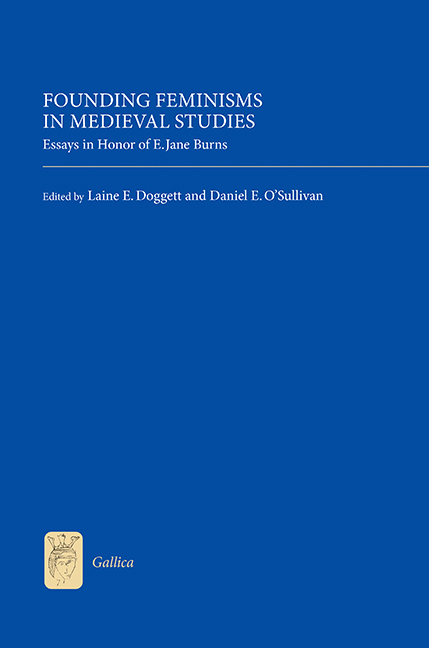Book contents
- Frontmatter
- Contents
- List of Illustrations
- List of Contributors
- Acknowledgements
- Introduction: The Work of E. Jane Burns and the Feminisms of Medieval Studies
- E. Jane Burns: A Bibliography
- Part I Debating Gender
- Part II Sartorial Bodies
- Part III Mapping Margins
- Part IV Female Authority: Networks and Influence
- Anne de Bretagne and Anne de France: French Female Networks at the Dawn of the Renaissance
- Staging Female Authority in Chantilly MS 522: Marguerite de Navarre's La Coche
- Babies and Books: The Holy Kinship as a Way of Thinking About Women's Power in Late Medieval Northern Europe
- Page Layout and Reading Practices in Christine de Pisan's Epistre Othea: Reading with the Ladies in London, BL, MS Harley 4431
- Afterword: A Response to the Volume
- Index
- Tabula Gratulatoria
- Already Published
Anne de Bretagne and Anne de France: French Female Networks at the Dawn of the Renaissance
from Part IV - Female Authority: Networks and Influence
Published online by Cambridge University Press: 05 July 2016
- Frontmatter
- Contents
- List of Illustrations
- List of Contributors
- Acknowledgements
- Introduction: The Work of E. Jane Burns and the Feminisms of Medieval Studies
- E. Jane Burns: A Bibliography
- Part I Debating Gender
- Part II Sartorial Bodies
- Part III Mapping Margins
- Part IV Female Authority: Networks and Influence
- Anne de Bretagne and Anne de France: French Female Networks at the Dawn of the Renaissance
- Staging Female Authority in Chantilly MS 522: Marguerite de Navarre's La Coche
- Babies and Books: The Holy Kinship as a Way of Thinking About Women's Power in Late Medieval Northern Europe
- Page Layout and Reading Practices in Christine de Pisan's Epistre Othea: Reading with the Ladies in London, BL, MS Harley 4431
- Afterword: A Response to the Volume
- Index
- Tabula Gratulatoria
- Already Published
Summary
This article examines female networks in two French royal families of the late medieval and early Renaissance periods through a study of the paratextual dynamics in books chosen by women for other women. I concentrate on the female lineage generated by Anne de France (1461–1522), duchess of Bourbon, daughter and sister of two kings (Louis XI, Charles VIII) and unofficial regent of France (1483–1491), and Anne de Bretagne (1477–1514), twice queen of France as spouse of Charles VIII and Louis XII. Not only were these two women interconnected through Charles VIII, but an important correlation can be established between their progeny and the posterity of their books. Because neither of the two Annes produced a male heir, their cultural legacies can be partially measured through the manuscripts they had made for their female offspring.
In focusing on two works whose creation was initiated by these mothers for their daughters, Anne de France's Enseignements [Lessons] and the Primer of Claude de France, commissioned by Anne de Bretagne, I wish to argue that French family female networking relied on the book as a site of convergence, rather than a site of struggle and contestation, as was often the case of male-authored works for and about women. To contextualize the remarkable way in which the duchess and queen had these material objects and gifts fashioned for their female offspring, I first examine the traditional mode of the transfer of knowledge to women – from male to female – in Symphorien Champier's Nef des dames vertueuses.
Inviting Anne de France and her daughter Suzanne de Bourbon (1491–1521) to consider examples of female virtue, Symphorien Champier dedicated his printed edition of the Nef des dames vertueuses, published in Lyon in 1503, to both mother and daughter, thereby bonding them in a simultaneous sharing of his work. Book I of the Nef des dames, which exploits the popular famous-women topos, begins not with a verbal dedication to the duchess, like many contemporary works, but rather with a literary tribute to Anne de France, who is integrated into the prologue's allegorical staging of the work: following Lady Prudence's request that the author–narrator write a defense of women, a figure suddenly appears on the scene in the guise of the duchess of Bourbon to serve as a model of virtue.
- Type
- Chapter
- Information
- Founding Feminisms in Medieval StudiesEssays in Honor of E. Jane Burns, pp. 171 - 186Publisher: Boydell & BrewerPrint publication year: 2016



